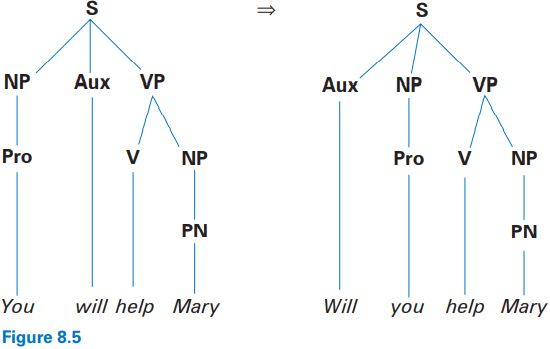
Movement rules
 المؤلف:
George Yule
المؤلف:
George Yule
 المصدر:
The study of language
المصدر:
The study of language
 الجزء والصفحة:
103-8
الجزء والصفحة:
103-8
 17-2-2022
17-2-2022
 3313
3313
The very small set of phrase structure rules just described is a sample of what a more complex phrase structure grammar of English, with many more parts, would look like. These rules can be treated as a representation of the underlying or deep structures of (1) S (6) S NP VP NP VP Art N V NP Pro V NP Art N Pro A dog followed the boy You saw it Figure 8.4 Syntax 103 sentences in English. One feature of these underlying structures is that they will generate sentences with a fixed word order. That is convenient for creating declarative forms (You will help Mary), but not for making interrogative forms, as used in questions (Will you help Mary?). In making the question, we move one part of the structure to a different position. This process is based on a movement rule.
In order to talk about this process, we need to expand our phrase structure rules to include an auxiliary verb (Aux) as part of the sentence. This is illustrated in the first rewrite rule below. Auxiliary verbs (sometimes described as “helping” verbs) take different forms in English, but one well-known set can be included in the rudimentary lexical rule for Aux below. We also need a lexical rule that specifies the basic forms of the verbs, shown as the third rewrite rule below.

With these components, we can specify a simple movement rule that is involved in the creation of one basic type of question in English.

This type of rule has a special symbol ⇒ and can be illustrated in the process of one tree, on the right, being derived from the tree on the left.

Using this simple rule, we can also generate these other questions:

These are all surface structure variations of a single underlying structure. However, we still have not incorporated recursion.
 الاكثر قراءة في Syntax
الاكثر قراءة في Syntax
 اخر الاخبار
اخر الاخبار
اخبار العتبة العباسية المقدسة


